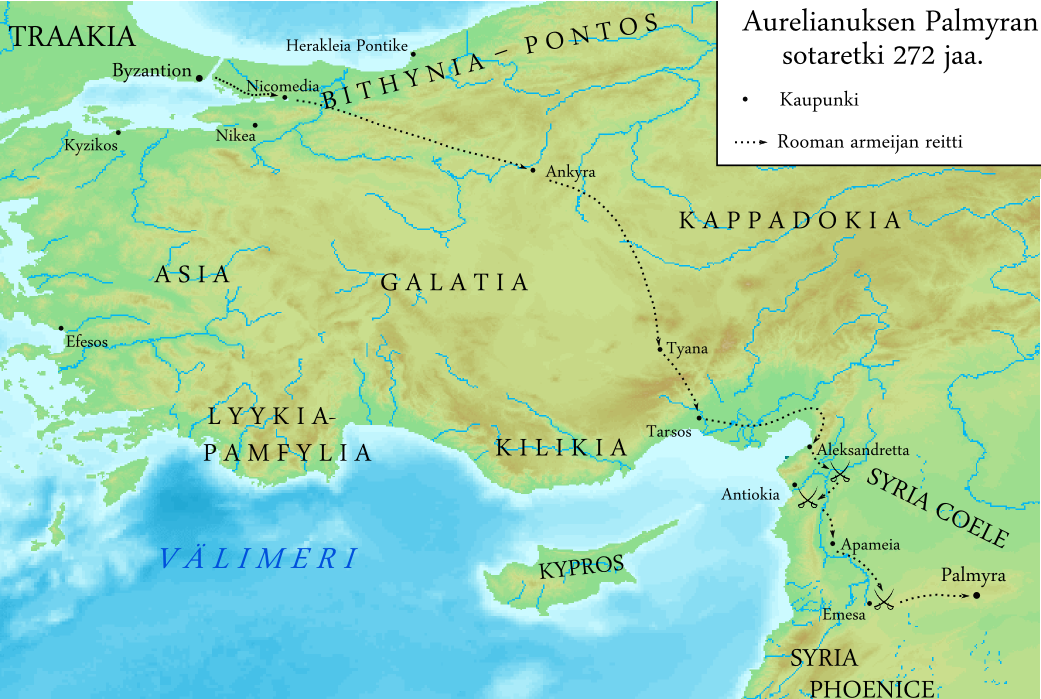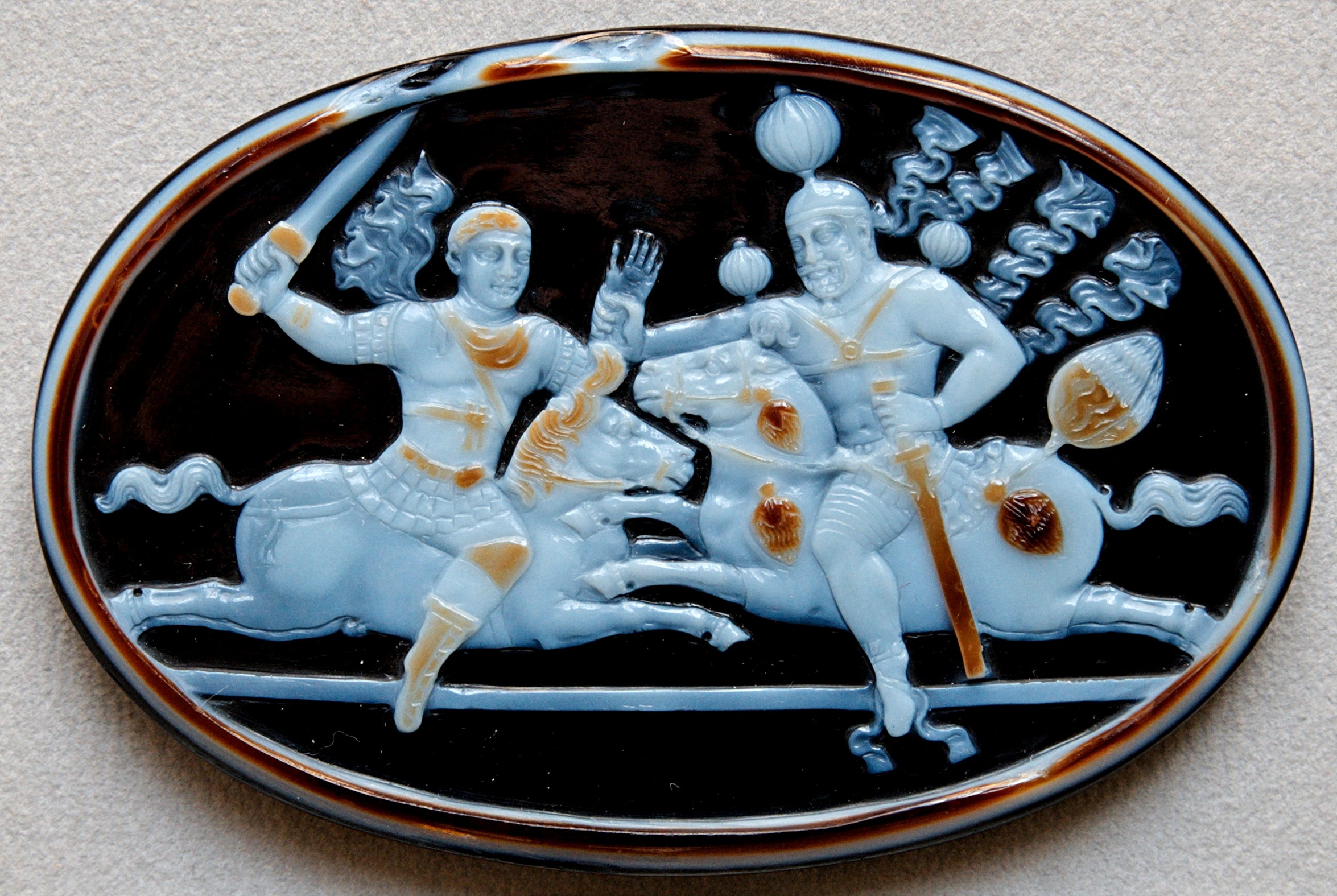|
Marcus Aurelius Probus
Marcus Aurelius Probus (; 230–235 – September 282) was Roman emperor from 276 to 282. Probus was an active and successful general as well as a conscientious administrator, and in his reign of six years he secured prosperity for the inner provinces while withstanding repeated invasions of barbarian tribes on almost every sector of the frontier. After repelling the foreign enemies of the empire, Probus was forced to handle several internal revolts but demonstrated leniency and moderation to the vanquished wherever possible. Despite the military basis of his power, he presented himself as a constitutional monarch who respected the authority of the Roman Senate.Gibbon, p. 283 Upon defeating the Germans, Probus re-erected the fortifications of emperor Hadrian between the Rhine and Danube rivers, protecting the Agri Decumates, and exacted from the vanquished a tribute of manpower to resettle depopulated provinces within the empire and provide for adequate defense of the frontie ... [...More Info...] [...Related Items...] OR: [Wikipedia] [Google] [Baidu] |
Capitoline Museums
The Capitoline Museums () are a group of art and archaeology, archaeological museums in Piazza del Campidoglio, on top of the Capitoline Hill in Rome, Italy. The historic seats of the museums are Palazzo dei Conservatori and Palazzo Nuovo, facing on the central trapezoidal piazza in a plan conceived by Michelangelo in 1536 and executed over a period of more than 400 years. The Capitoline Museums, known for its exhibitions of works related to the history of ancient Rome and the Capitoline Hill, which was the political and religious center of the city, express the greatness of Roman civilization and its precious legacy that helped influence modern Western culture, Western society. The museums display works from the ancient world (Greek, Roman, Etruscan and Egyptian), the Middle Ages and the Renaissance. They house masterpieces such as the ''Equestrian Statue of Marcus Aurelius'', the ''Capitoline Wolf'', the ''Dying Gaul'', the Bust of ''Medusa (Bernini), Medusa'' by Gian Lorenzo Be ... [...More Info...] [...Related Items...] OR: [Wikipedia] [Google] [Baidu] |
Dometius Of Byzantium
Dometius of Byzantium ( Greek: Δομέτιος; died 284) was bishop of Byzantium from about 272 to about 284. He was a brother of the Roman emperor Probus. He converted to Early Christianity, and entered the clergy when he was baptised by the bishop of Byzantium Titus of Byzantium, whom he succeeded. He had two sons, Probus Probus may refer to: People * Marcus Valerius Probus (c. 20/30–105 AD), Roman grammarian * Marcus Pomponius Maecius Probus, consul in 228 * Probus (emperor), Roman Emperor (276–282) * Probus of Byzantium (–306), Bishop of Byzantium from 293 t ... and Metrophanes, who later became bishops of the same city. [...More Info...] [...Related Items...] OR: [Wikipedia] [Google] [Baidu] |
Rhaetia
Raetia or Rhaetia ( , ) was a Roman province, province of the Roman Empire named after the Rhaetian people. It bordered on the west with the country of the Helvetii, on the east with Noricum, on the north with Vindelicia, on the south-west with Gallia Narbonensis, Transalpine Gaul and on the south with Venetia et Histria, a region of Roman Italy. It thus comprised the districts occupied in modern times by eastern and central Switzerland (containing the Upper Rhine and Lake Constance), southern Germany (Bavaria and most of Baden-Württemberg), Vorarlberg and the greater part of Tyrol (state), Tyrol in Austria, and part of northern Lombardy in Italy. The region of Vindelicia (today eastern Württemberg and western Bavaria) was annexed to the province at a later date than the others. The northern border of Raetia during the reigns of Roman emperor, emperors Augustus and Tiberius was the River Danube. Later the Limes Germanicus marked the northern boundary, stretching for 166 ... [...More Info...] [...Related Items...] OR: [Wikipedia] [Google] [Baidu] |
Franks
file:Frankish arms.JPG, Aristocratic Frankish burial items from the Merovingian dynasty The Franks ( or ; ; ) were originally a group of Germanic peoples who lived near the Rhine river, Rhine-river military border of Germania Inferior, which was the most northerly province of the Roman Empire in continental Europe. These Frankish tribes lived for centuries under varying degrees of Roman hegemony and influence, but after the collapse of Roman institutions in western Europe they took control of a large empire including areas which had been ruled by Rome, and what it meant to be a Frank began to evolve. Once they were deeply established in Gaul, the Franks became a multilingual, Catholic Christian people, who subsequently came to rule over several other post-Roman kingdoms both inside and outside the old empire. In a broader sense much of the population of western Europe could eventually described as Franks in some contexts. The term "Frank" itself first appeared in the third cent ... [...More Info...] [...Related Items...] OR: [Wikipedia] [Google] [Baidu] |
Gaul
Gaul () was a region of Western Europe first clearly described by the Roman people, Romans, encompassing present-day France, Belgium, Luxembourg, and parts of Switzerland, the Netherlands, Germany, and Northern Italy. It covered an area of . According to Julius Caesar, who took control of the region on behalf of the Roman Republic, Gaul was divided into three parts: Gallia Celtica, Gallia Belgica, Belgica, and Gallia Aquitania, Aquitania. Archaeologically, the Gauls were bearers of the La Tène culture during the 5th to 1st centuries BC. This material culture was found throughout Gaul and as far east as modern-day southern Poland, Slovakia, and Hungary. Warbands led by the Gaul Brennus (leader of the Senones), Brennos Battle of the Allia, sacked Rome in 387 BC, becoming the only time Rome was conquered by a foreign enemy in 800 years. However, Gallia Cisalpina was conquered by the Romans in 204 BC and Gallia Narbonensis in 123 BC. Gaul was invaded after 120 BC by the Cimbri ... [...More Info...] [...Related Items...] OR: [Wikipedia] [Google] [Baidu] |
Aurelian
Aurelian (; ; 9 September ) was a Roman emperor who reigned from 270 to 275 AD during the Crisis of the Third Century. As emperor, he won an unprecedented series of military victories which reunited the Roman Empire after it had nearly disintegrated under the pressure of barbarian invasions and internal revolts. Born in modest circumstances, most likely in Moesia, Moesia Superior, he entered the Roman army in 235 and climbed up the ranks. He went on to lead the cavalry of the emperor Gallienus, until Gallienus' Gallienus#Assassination, assassination in 268. Following that, Claudius Gothicus became emperor until his own death in 270. Claudius' brother Quintillus then ruled for three months, before Aurelian took the empire for himself. Aurelian was chosen Roman emperor by the Illyrians, Illyriciani as one of themselves. During his reign, he defeated the Alamanni after a devastating war. He also defeated the Goths, Vandals, Juthungi, Sarmatians, and Carpi (people), Carpi. Aurelian ... [...More Info...] [...Related Items...] OR: [Wikipedia] [Google] [Baidu] |
Claudius II
Marcus Aurelius Claudius "Gothicus" (10 May 214 – August/September 270), also known as Claudius II, was Roman emperor from 268 to 270. During his reign he fought successfully against the Alemanni and decisively defeated the Goths at the Battle of Naissus. He died after succumbing to a "pestilence", possibly the Plague of Cyprian that had ravaged the provinces of the Empire. Early life and origin The most significant source for Claudius II (and the only one regarding his early life) is the collection of imperial biographies called the ''Historia Augusta''. However, his story, like the rest of the ''Historia Augusta'', is riddled with fabrications and obsequious praises. In 4th century, Claudius was declared a relative of Constantine the Great's father, Constantius Chlorus, and, consequently, of the ruling dynasty. The ''Historia Augusta'' should be used with extreme caution and supplemented with information from other sources: the works of Aurelius Victor, Pseudo-Aurelius ... [...More Info...] [...Related Items...] OR: [Wikipedia] [Google] [Baidu] |
Illyricum (Roman Province)
Illyricum was a Roman province that existed from 27 BC to sometime during the reign of Vespasian (69–79 AD). The province comprised the regions of Illyria/Dalmatia in the south and Pannonia in the north. Illyria included the area along the east coast of the Adriatic Sea and its inland mountains. Pannonia included the northern plains that now are part of Serbia, Croatia and Hungary. Illyricum included part or all of the territories of today's Albania, Kosovo, Montenegro, Serbia, Bosnia and Herzegovina, Croatia and Slovenia. Name and etymology The term Illyrians was used to describe the inhabitants of the area as far back as the late 6th century BC by Hecataeus of Miletus. Geography Illyria/Dalmatia stretched from the Drin (river), River Drin (in modern northern Albania) to Istria (Croatia) and the River Sava in the north. The area roughly corresponded to modern northern Albania, Kosovo, Serbia, Slovenia, Montenegro, Bosnia and Herzegovina and coastal Croatia (Dalmatiae). Pa ... [...More Info...] [...Related Items...] OR: [Wikipedia] [Google] [Baidu] |
Sarmatia
Sarmatia was a geographic region defined in the ancient Graeco-Roman world that encompassed the western Eurasian steppe. It was inhabited by Sarmatians, an ancient Eastern Iranian equestrian nomadic people. Sarmatia was the name given by the Romans to the region which had formerly been known to the ancient Greeks as Scythia because it had been inhabited by the Scythians. Beginning in the late 4th century BC, a related nomadic Iranian people, the Sarmatians, moved from the east into the Pontic steppe, where they replaced the Scythians as the dominant power. Due to the Sarmatian incursion, "" replaced "" as the name for the region. Geography According to the map of Marcus Vipsanius Agrippa transmitted by Pliny the Elder in the late 1st century BCE, Sarmatia and Scythia Taurica were the countries between the Dnipro, the Volga and Ciscaucasia; and Pomponius Mela in the 1st century CE described Sarmatia as a large country found between the Vistula and the Ister. Claudius Ptol ... [...More Info...] [...Related Items...] OR: [Wikipedia] [Google] [Baidu] |
Valerian (emperor)
Valerian ( ; ; – 260 or 264) was Roman emperor from 253 to spring 260 AD. Valerian is known as the first Roman emperor to have been taken captive in battle, captured by the Sassanid Empire, Persian emperor Shapur I after the Battle of Edessa, causing shock and instability throughout the Roman Empire. The unprecedented event and his unknown fate generated a variety of different reactions and "new narratives about the Roman Empire in diverse contexts". Biography Origins and rise to power Unlike many of the would-be emperors and rebels who vied for imperial power during the Crisis of the Third Century, Valerian was of a noble and traditional Roman Senate, senatorial family. Details of his early life are sparse, except for his marriage to Egnatia Mariniana, with whom he had two sons: Publius Licinius Egnatius Gallienus (his co-emperor and later successor) and Licinius Valerianus (brother of Gallienus), Licinius Valerianus. Valerian was Roman consul, consul for the first time eit ... [...More Info...] [...Related Items...] OR: [Wikipedia] [Google] [Baidu] |
Military Tribune
A military tribune () was an officer of the Roman army who ranked below the legate and above the centurion. Young men of Equestrian rank often served as military tribunes as a stepping stone to the Senate. The should not be confused with the elected political office of tribune of the people () nor with that of . Early Rome The word ''tribunus'' derives from '' tribus'', "tribe". In Rome's earliest history, each of the three tribes (Ramnes, Luceres, and Tities) sent one commander when an army was mustered, since there was no standing army. The tribunes were commanders of the original legion of 3,000. By the time of the Greek historian Polybius (d. 118 BC), the tribunes numbered six, and they were appointed by the consuls. However, the process by which tribunes were chosen and assigned is complex and varies at different times. Republican period In the Republican period, there were six appointed to each legion. Authority was given to two at a time, and command rotated amo ... [...More Info...] [...Related Items...] OR: [Wikipedia] [Google] [Baidu] |







